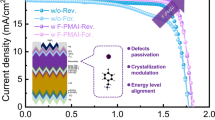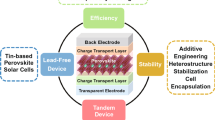Abstract
The effects of different annealing processes on the photovoltaic (PV) properties and the spectral response as well as minority carrier lifetime in the bulk of unanalyzed PF5 ion implantation poly-Si solar cells were investigated. The different hydrogen passivation effects of defects in poly-Si induced by three heat treatment processes are reported. We used RTA-rapid thermal annealing, YAG pulse laser annealing and CTSA-classical three-step annealing for this study. The results show that cells processed by RTA (800°C, 4 sec) achieved the best PV properties and spectral response among all annealed samples. Under this precess condition, no or few defects were induced in bulk. While RTA (>-850°C for 4 sec), CTSA as well as YAG laser processes induced defects of different nature and concentration in the bulk of cells. It is further shown that hydrogen ion implantation significantly improved, the performances of poly-Si cells. It is able to efficiently remove the YAG laser induced defects in bulk. However, it cannot completely passivate the defects induced by CTSA and RTA processes.
Similar content being viewed by others
References
Li Jin-chai, Xia Bai-hua, Wu Xian-guo,et al., Lowenergy H+ implantation effects on the characteristics of polysilicon solar cells[J].Nucl. Instr and Meth in Physics Research B, 1991,59/60: 1110–1112.
Coppye J, Szlufuk J, Elgamel H E,et al. Effect of hydrogen plasma passivation on the efficiency of polycrystalline silicon solar cells[C].The Proc of 22th IEEE PVSC. USA: Las Vegas, 1991, 873–876.
Baert K, Murai H, Kobayashi K,et al. Hydrogen passivation of polysilicon thin-film transistors by electron cyclotron resonance plasma[J].Jpn J Appl Phys, 1993,32: 2601–2606.
Cielaszyk E S, Kirmse K H R, Stewart R A,et al. Mechanisms for polycrystalline silicon defect passivation by hydrogenation in an electron cyclotron resonance plasma[J].Appl Phys Lett, 1995,67: 3099–3101.
Bernstein J D, Qin S, Chan C,et al. High dose-rate hydrogen passivation of polycrystalline silicon CMOS TFT’s by plasma ion implantation[J].IEEE Trans Electron Devices, 1996,43, 1876–1882.
Slaoui A, Barhdadi A, Muller J C,et al. Passivation of laser induce defects in silicon by low energy hydrogen ion implantation[J].Appl Phys A, 1986,39: 159–1621.
Author information
Authors and Affiliations
Corresponding author
Additional information
Biography: LI Jin-chai (1946-), male, Associate professor. Research direction: studies of ion beam modification of materials and films of new functionail materials.
Rights and permissions
About this article
Cite this article
Jin-chai, L., Muller, J.C. & Siffert, P. H+ passivation of poly-si solar cells processed by different annealing processes. Wuhan Univ. J. Nat. Sci. 4, 295–298 (1999). https://doi.org/10.1007/BF02842354
Received:
Issue Date:
DOI: https://doi.org/10.1007/BF02842354




